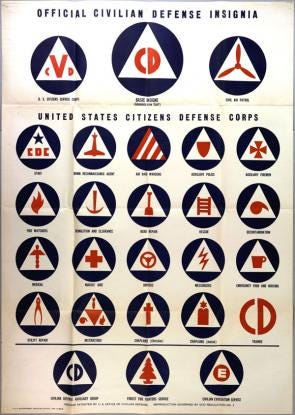What's It Wednesday - Civil Defense Sniff Kit
May 20, 1941, before the United States entered the war, President Franklin Roosevelt set up the Office of Civilian Defense to coordinate measures to protect citizens.
History Buzz writer Marilyn Helmers is taking a much needed break from What’s It Wednesdays. Since April 2020 - long before History Buzz was a thing - Marilyn has written a total of 88 What’s It Wednesdays posts. That’s a lot of What’s Its! You can read all of Marilyn’s posts through the About tab on the History Buzz homepage. Scroll down to People and click on Marilyn’s name. Or you can click here to go there directly.
What’s it Wednesdays will continue through other members of the History Buzz team. Stay tuned!
What's It Wednesday - Civil Defense Sniff Kit
This Sniff Kit was used by civil defense and Air Raid Precaution (ARP) wardens during World War II to acquaint civil defense authorities with the characteristics of poisonous gases used during World War I. Although poisonous gas was not used during World War II, experiences during the previous war raised the concern.

Why was poisonous gas not used in World War II? There are many theories. Some posit that Hitler had an aversion to using gas after being exposed to mustard gas in World War I. Others theorize that German manufacturing wasn’t up to the task, or that they relied on tanks and speed rather than poisonous gas.
The small bottles, or vials, contained a harmless liquid that smelled like the gas in question. Each bore a label that described the symptoms and treatment and neutralization of each gas relevant to their respective containers. The most common poisonous gases replicated were: mustard gas, lewisite, phosgene gas, chloropicrin gas, and tear gas.
SNIFF KIT
Approved and Recommended by the Office of Civilian Defense and the Chemical Warfare Service of The U.S. Army
The Sniff Kit is designed to provide an easy and safe method of identifying the five principal gases used in chemical warfare.
The case is made of wood and pressboard, covered with serviceable quality of saddle tan fabric. It contains five bottles with ground glass stoppers, charged with the following contents:
An imitation of Mustard Gas (HS)
An imitation of Phosgene Gas (CG)
An imitation of Chlorpicrin (PS)
An imitation of Lewisite (MI) or (M-1)
An imitation of Tear Gas (CN)
Each bottle is labeled with simple information describing the physiological effect of the active gas; first aid steps for treating victims; field neutralization methods; the U.S. Army symbols, and the popular names to aid in memorizing them.
Out of sixteen possible variants, the Office of Civilian Defense and Chemical Warfare Service have selected these five as being basic representatives for civilian training in recognizing and counteracting actual gases used in chemical warfare.
The life of each of these imitations is guaranteed for not less than four months of normal use, provided the bottles are kept tightly closed when not in use.
Price: $5.00 each prepaid to any point in the U.S.A Write directly to the Northam Warren Corporation, Stamford, Connecticut for descriptive literature and information concerning replacing of simulated gases at a nominal cost.
NORTHAM WARREN CORPORATION
STAMFORD, CONNECTICUT
Civil defense
Civil defense refers to a system of defensive measures designed to protect civilians and their property from enemy attack. During World War II, the U.S. civil defense system included bomb shelters, air raid warning systems, patrols along the nation's borders, and distribution of information on emergency survival. Citizens who had not joined the nation's armed forces were eager to support the war effort in any way they could. They joined civil defense organizations in their local communities, volunteering to help construct bomb shelters and distribute survival tips.
Today the Civil Air Patrol (CAP) is a partner and auxiliary of the U.S. Air Force. The CAP is there to search for and find the lost, provide comfort in times of disaster and work to keep the homeland safe. Its 56,000 members selflessly devote their time, energy and expertise toward the well-being of their communities, while also promoting aviation and related fields through aerospace/STEM education and helping shape future leaders through CAP’s cadet program in nearly 1,500 communities nationwide. You can learn more about the Civil Air Patrol here (link).
How about you? Do you know anyone in the Civil Air Patrol?
Thanks for reading! And thank you, Marilyn, for researching and writing What’s It Wednesdays for so many months!
~Elaine
If you enjoy reading History Buzz and What’s It Wednesdays, please consider becoming a paid subscriber. You’ll help support the research and writing that makes History Buzz possible. And you’ll have our undying appreciation!







Thank you, Marilyn. No, I don't know anyone in civil air patrol personally. I was asked if I was interested (by someone who was involved in it on the NH seacoast).
Another beauty, Marilyn!
When I was a kid at St. Monica's grade school in Detroit, one of my classmates and a fellow Boy Scout was in the CAP. Other than those two admirable attendance, he was a bit odd, as my sainted mom loved to say! Years later during my stint managing communications for the Animal Rescue League of Boston, I went toured my first (and to date only!) air raid shelter. It was in ARL of B's basement - a massive, dark and other-worldly room. Not someplace I'd enjoy spending more than 5 minutes in.
In recent months I think of ARL's air raid shelter when I watch the evening news about the Ukraine.
Great post, Marilyn!
Tom